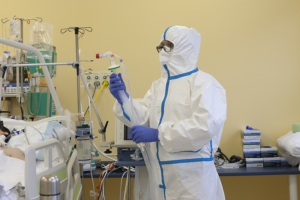Congress Newsletter 2021
EA21 Newsletter: Session COVS1 Covid-19 induced respiratory failure
Saturday December 18, 08:15 – 09:15 – Channel 3
This three-part session on the complicated pathogenesis of Covid-19 induced respiratory failure will be opened by Professor Paolo Pelosi, Anesthesia and Critical Care – San Martino Policlinico Hospital – IRCCS for Oncology and Neurosciences – Genoa and Department of Surgical Sciences and Integrated Diagnostics – University of Genoa – Italy.
He will explain severe COVID-19 pneumonia shares several features with non-COVID-19 pulmonary acute respiratory distress syndrome (ARDS) since both are characterised by inflammatory lung injury, parenchymal stiffening and consolidation, alveolar and airway collapse and closure, altered vascular permeability, and diffuse alveolar damage (DAD).
Non-invasive respiratory support (NIRS) represents a possible first step in the management of COVID-19 patients, and the timing of intubation in COVID-19 seems not to influence clinical outcomes. Early intubation can be considered in patients with COVID-19 phenotype 2 (or H) who are at higher risk of disease progression,

In the presentation “Mechanical Ventilation in COVID-19”, Dr Juliana Ferreira (Hospital das Clínicas and Faculty of Medicine, University of Sao Paulo, Brazil) will address the indication for ventilatory support in acute respiratory failure in COVID-19, summarise the reported use and outcomes of mechanical ventilation in COVID-19 in the literature, and review current recommendations for ventilatory support in COVID-19.
She says “I will present the results of large epidemiological studies estimating the need for mechanical ventilation to be between 30-90%, depending on the population included. In the UK, it has also been found that non-survivors were disproportionally non-white and from more deprived areas, underscoring that health inequities play a role in critical COVID-19 outcomes. Studies including critically ill patients reported the use of moderate-to-high PEEP, high FIO2, and good adherence to protective ventilation (tidal volumes 4-8mL/Kg of predicted body weight and plateau pressures below 30 cmH2O).”
She concludes: “Importantly, protective ventilation was associated with increased survival in a large cohort of critical patients in Brazil. Current recommendations include the use of protective ventilation, a trial of higher PEEP tailored to individual response, and prone positioning for 12-16 hours for patients with PF ratios <150.”
The third talk in this session on “Non-invasive respiratory support and patient self-inflicted lung injury in Covid-19” will be given by Professor Christian Putensen, University Hospital Bonn, Germany.
Read More of our special newsletter covering our virtual congress









